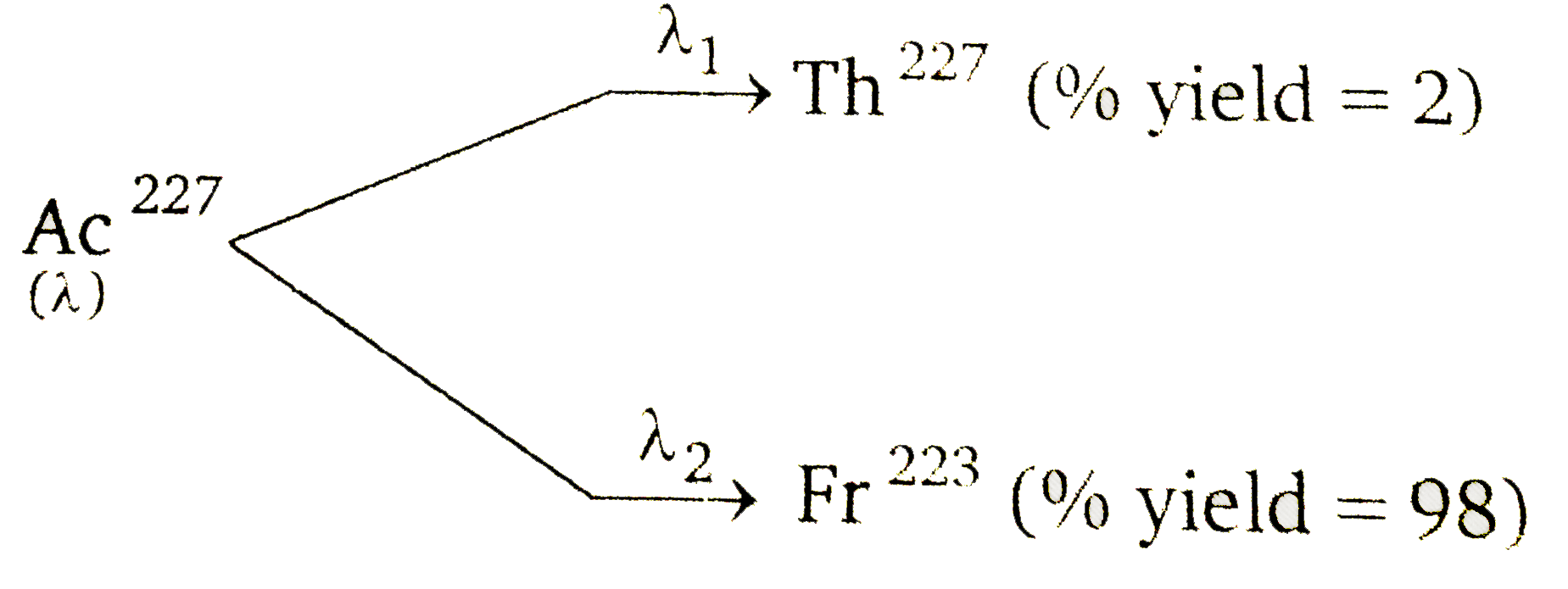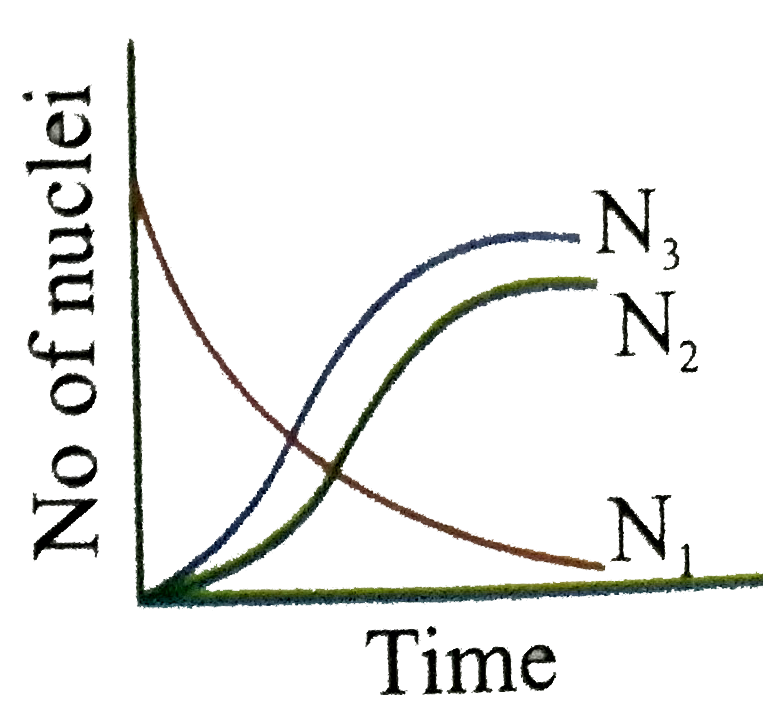Ac227 has a half life of 22 year . The decay follows two parallel paths, one leading the Th227 and the other leading to Fr223. The precentage yields of these two daughters nucleoids are 2% and 98 % respectively. What is the rate constant in yr−1, for each of the separate paths ?
The correct Answer is:6.30×10−4yr−1,3.087×10−2yr−1
KAc=0.693t1/2=0.69322=0.0315y

K=K1+K2⇒0.0315......(1)
K1K2=0.020.98=149
K2=49K1
K1+49K1=0.0315
K1=0.031550=6.3×10−4yr
K2=0.0315−6.3×10−4
K2=3.087×10−2yr
Topper's Solved these Questions
- RADIO ACTIVITYBook:BANSALChapter:RADIO ACTIVITYExercise:Exercise-4
Explore 12 Videos
- RADIO ACTIVITYBook:BANSALChapter:RADIO ACTIVITYExercise:Exercise-2
Explore 21 Videos
- P BLOCK ELEMENTSBook:BANSALChapter:P BLOCK ELEMENTSExercise:Exercise 3
Explore 20 Videos
- SOLUTIONSBook:BANSALChapter:SOLUTIONSExercise:Exercise4
Explore 32 Videos
Similar Questions
227Ac has a half-life of 21.8 years with respect to radioactive decay. The decay follows two parallel paths, one leading to 227Th and the other leading to 223Fr. The percentage yields of these two daughter nuclides are 1.2% and 98.8% respectively. what is the rate constant in y−1, for each of the separate paths?
View Solution.227Ac has a half-line of 22 year with respect to radiioactive decay. The decay follows two parallel paths, one leading to .227Th and the other leading to .223Fr. The percentage yiedls of these two daughter nuclides are 2% and 98.0% respectovely. What is the rate constant in year−1, for each of the separate paths?
View Solution
Knowledge Check
Ac227 has a half-life of 22 years . The decays follows two parallel paths

What are the decay constant (λ) for Th and Fr respectively ?A0.03087,0.00063B0.00063,0.03087C0.02,0.98DNone of these227Ac has a half-life of 22 years with respect to radioactive decay. The decay follows two prallel paths : 227Ac→227Th and 227Ac→223Fr. If the percentage of the two daughter nuclides are 2.0 and 98.0, respectively, the decay constant (in year−1) for 227Ac→227Th path is closest to
A6.3×10−2B6.3×10−3C6.3×10−1D6.3×10−4Uranium .23892U is an ustable nucleus. It decays to Thorium .23892Th, which is again an unstable nucleus which further decays to .23491Pa. Let .23892U be called A of decay constant λ1 and .23490Th is called as B of decay constant λ2 and stable nuclei .23491Pa be called as C. Here A is called parent nucleus and B is called daughter nucleus of A. Any two adjacent nuclei may be consider parent or daughter nuclei A,B and C respectively at time 't'.
Then we can write Aλ1−−→Bλ2−−→C
Rate of disintergration of A=dN1dt=λ1N1
Rate of disintergration of B=dN2dt=λ1N1−λ2N2
Rate of formation of nuclei C is equal to
dN3dt=λ2N2
If at t=0, there are N0 number of nuclei of A where as nuclei B and C are absent in the sample Answer the following questions
The graph N1,N2 and N3 with time can be best represent byA B
B C
C D
D
Ac227 has a half− life of 22.0 years with respect to one leading . To Th227 and the other to Fr227. The percentage yields of these two daughter nuclides are 2.0 and 98.0, respectively . What are the decay constants (λ) for each of the separate paths ?
View SolutionTrans 1,2-dideuterocyclopropane (A) undergoes a first order decompoistion. The observed rate constant at a certain temperature, measured in terms of disapperance of A was 1.52×10−4s−1. The analyiss of Products shwoed that the reaction followed two parallel paths, one leading to dideuteropropane (B) and the other to cis-1,2-dideuterocyclopropane (c). (B) was found to constitute 11.2% of the reaction Product, independently of the extent of reaction. What is the order of reaction for each path and what is the value of the rate constant for the formation of each of the Products ?
View SolutionTwo parallel beams of light P and Q (separation d) containing radiation of wavelengths 4000A and 5000A (which are mutually coherent in each wavelength separately) are incident normally on a prism as shown in fig. The refractive index of the prism as a function of wavelength is given by the relation. μ(λ)=1.20+bλ2 Where λ is in A and b is positive constant. The value of b is such that the condition wave length and is not satisfied for the other.
(a) Find the value of b.
(b) find the deviation of the beams transmitted through the face AC. (c) A convergent lens is used to bring these transmitted beams into focus. If the intensities of transmission form the face AC, are 41 and I respectively, find the resultant intensity at the focus.

View SolutionUranium .23892U is an ustable nucleus. It decays to Thorium .23892Th, which is again an unstable nucleus which further decays to .23491Pa. Let .23892U be called A of decay constant λ1 and .23490Th is called as B of decay constant λ2 and stable nuclei .23491Pa be called as C. Here A is called parent nucleus and B is called daughter nucleus of A. Any two adjacent nuclei may be consider parent or daughter nuclei A,B and C respectively at time 't'.
Then we can write Aλ1−−→Bλ2−−→C
Rate of disintergration of A=dN1dt=λ1N1
Rate of disintergration of B=dN2dt=λ1N1−λ2N2
Rate of formation of nuclei C is equal to
dN3dt=λ2N2
If at t=0, there are N0 number of nuclei of A where as nuclei B and C are absent in the sample Answer the following questions
Number of nuclei of B at any time t is
View SolutionUranium .23892U is an ustable nucleus. It decays to Thorium .23892Th, which is again an unstable nucleus which further decays to .23491Pa. Let .23892U be called A of decay constant λ1 and .23490Th is called as B of decay constant λ2 and stable nuclei .23491Pa be called as C. Here A is called parent nucleus and B is called daughter nucleus of A. Any two adjacent nuclei may be consider parent or daughter nuclei A,B and C respectively at time 't'.
Then we can write Aλ1−−→Bλ2−−→C
Rate of disintergration of A=dN1dt=λ1N1
Rate of disintergration of B=dN2dt=λ1N1−λ2N2
Rate of formation of nuclei C is equal to
dN3dt=λ2N2
If at t=0, there are N0 number of nuclei of A where as nuclei B and C are absent in the sample Answer the following questions ltbgt Numeber of the nuclei of nuclei C at time t is
View Solution
